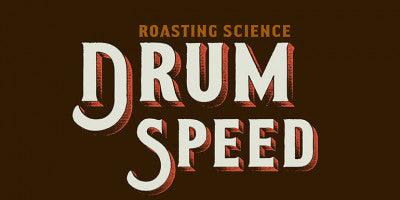
The Importance of Drum Speed in Roasting Coffee
The Importance of Drum Speed in Coffee Roasting
One of the first things you learn about roasting coffee is that time, temperature, and airflow are the foundations of any roast profile.
Each roast profile must have time; meaning a duration, but time also can pertain to certain intervals of time between specific events in the roast and their relationship to each other events, and also the chronology of those events along a measured curve, with starting and ending time points. Coffee cannot roast without time.
However, you can have all the time in the world, but without heat no roast can occur. Coffee is a thermally charge beverage. Pyrolysis is the fancy term to describe the chemical change and decomposition of a carbon based material (i.e. a coffee bean) through the application of heat (the roast).
Airflow is vital to the roast as well. Its primary function is to apply heat to the coffee beans (convection) and remove smoke during the duration of the roast. In fact, airflow adjustments to a roast, which affects the heat distribution in the roasting drum and the heat concentration in the coffee bean, can impact the other roast variables.
More or less airflow can make the roast shorter or longer, as we will see in a moment, neither of these elements of the roast, which when treated as variables are absolute. Extreme or excess adjustments to the airflow can sometimes have the opposite effect as expected. While increasing airflow will tend to increase convection, which increases temperature and shortens roast duration, excessive airflow adjustment can reduce heat and actual lengthen roast duration. Welcome to the world of coffee roasting.
By adjusting anyone of these three elements of the roast, the whole profile of the roast can change. Adjusting the roast duration will give the coffee beans more or less time for development. By adjusting the temperature or the airflow, will affect the how the coffee beans will chemically decompose. Each modification to the any one of the elements will also have an on impact the others.
All of these elements are connected. More heat can make the roast finish early, less heat the roast goes long. Since the airflow effects the coffee beans interaction with heat in the roast in can also affect duration as well. Change in time will affect the temperatures and airflows impact on the coffee bean during the roast. As a roaster, you are always trying to keep time, temperature, and airflow in the proper respective proportions for any given roast profile.
Now let’s add one final variable, so significant to the roast that I consider it as the four element of the roasting. Yet, as significant as this variable is to a roast, it is rarely discussed in any meaningful way.
This fourth element is drum speed. Drum speed is the speed at which the drum inside the roasting chamber rotates. Drum speed is often expressed by a percentage value for each roasting system from 0% to 100%. However, that value will be relative to that roasting platform and in some cases relative to that specific machine. A more meaningful expression, and better way to grasp this concept, is to think of drum speed in revolutions per minute (RPM) across all roasting platforms.
As the drum turns the coffee beans are rotated. The slower the drum speed, the less the coffee beans are turned and vice versa. A roaster with a drum speed of zero, has no rotations per minute and would roast coffee with nearly 100% conductive heat.
Contrarily, a drum speed of high number of RPM’s, will decrease the amount of contact the beans have with the surface of the drum, thereby reducing conductive heat transfer. At the same time a higher RPM drum speed increases the convective heat transfer because the beans rotating (falling back to the drum surface) are briefly exposed to the temperature of the roasting chamber. The temperature (heat) is forced into the beans by the airflow of the roasting system.
Drum style roasters have a drum chamber that rotates to keep the coffee bean turning during the roast. As the coffee beans turn, they are actually momentarily removed from contact with the drum (conductive heat) and are penetrated by the heated airflow in the drum (convective heat). Convective heat is more efficient and penetrates the bean and roasts the coffee bean from the inside out. It is estimated that most modern drum roasters are 70/30 in favor of convective heat.
Enter variable drum speeds controls. The ability to adjust the speed at which the drum rotates is becoming more widely available on many commercial roasting machines. Variable drum controls allow the roaster to control the rotation of the beans in the drum. By controlling how the beans rotate and interact with drum chambers primary methods of heat exchange conductive and convective heating, the drum speed can affects overall temperature in the drum chamber. This adjustment then affects drum temperature, how the coffee beans interact with the airflow and in turn the roast time is impacted as well. . All core elements of the roast are affected by the change in drum speed.
While a roast profile might have the desired proportions of time, temperature, airflow, Time, temperature, and airflow, also most work in a careful ratio according the designs of a coffee profile. Now with changes to drum speed, temperature, the effectual use of airflow, the relationship between convective or conductive heat, and the duration of the roast can be impacted without any direct change to the temperature or airflow. In fact, a drum speed adjustment can also affect the duration of the roast and any number of time intervals and roast milestones and ultimately coffee development.
The three roasts elements, time, temperature, and airflow, just got more complex when you add in drum speed. You have to know your drum speed!